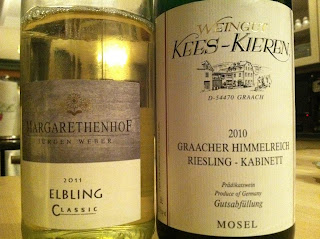| Spring colors at the brunch table |
Holy Week is such a special time - it’s all about celebrating rebirth and new life as we are reminded by the Resurrection. Easter is the most obvious celebration of Holy Week, but this year I wanted to try my hand at some recipes I’ve been meaning to learn or test, and since Easter Sunday is already packed with traditional foods, I opted for Palm Sunday to test the recipes on the family.
 |
| Mimosas with Pisani Prosecco |
What’s a Sunday brunch without mimosas? I’m not one for mixing wines with other ingredients but in the case of mimosa and bellini, I say bring on the bubbles and create a bright, fun drink! So mimosas it was, and for bubbles I chose Pisani Prosecco.
Brunch was eggs benedict with a light spring salad. For me, the proper pairing with egg dishes due to the texture of egg is anything with bubbles - it leaves the palate feeling clean again. A good quality Prosecco is perfect for mimosas and they worked beautifully with the eggs benedict.
| Eggs benedict |
I’m on a sort of quest to learn the five French “mother sauces” over the course of this year. First I learned bechamel and have been using it, but now to put a perfect hollandaise sauce to good use, eggs benedict does the trick. I had to learn to poach an egg properly and having heard some less than pleasant stories about how to poach the egg, I had a test run a few days before the brunch. It’s not difficult at all! I used some tips from Julia Child and some from other sources on the internet, and voila! Delicious eggs benedict with just the flavors and textures I had hoped to achieve. (I think the most important tips were water temperature, water to vinegar ratio, and poking the egg shell with the pin.)
| Light salad |
The eggs, buttered English muffins, crispy bacon, and rich hollandaise sauce needed a light side dish, so I chose frisee, Boston lettuce, shallots, and a basic lemon and local wildflower honey dressing with balsamic vinegar. Together with the mimosas, they were perfect with the eggs benedict.
 |
| Light dessert |
For a light dessert, I went with a mix of fresh raspberries, blackberries, and blueberries, topped with a dollop of fresh whipped cream, a hint of unsweetened cocoa powder, and some orange zest. Perfection.
Obviously we were quite satisfied after such a brunch, so a late dinner would be light. I chose fresh salmon which I rubbed with olive oil and crusted with almond, thyme, and rosemary, with a raspberry sauce. The side dish was wildflower honey braised endives. To match the salmon and raspberry, I chose a California Pinot Noir (Hahn is one of the family favorites as a dependable West Coast Pinot).
| Salmon and endives with Pinot Noir |
I’m getting toward the end of Julia Child’s book, My Life in France. I read last night in her book that when she and Simone Beck wrote their cookbook, Mastering the Art of French Cooking (aimed at teaching American cooks how to prepare traditional French dishes), at the time the book was in progress, American publishers were concerned that American cooks would not be interested in the book due to attention to detail deemed laborious. They felt that Americans see French detail as tedious and unnecessary. After having all of my poached eggs turn out perfectly by using a more detailed approach than most, and carefully executing the hollandaise sauce, I can honestly agree with Julia and “Simca” that the attention to detail is sometimes absolutely necessary. Yes, at times I like winging it and experimenting, but with traditional dishes, a cook must respect the years others have put into perfecting the recipes. And when the recipes turn out well, it’s so satisfying to know it was done correctly.
Easter dinner has been planned out and I’m looking forward to it - there will be some traditional dishes for the holiday, and some experimental dishes as well - so I’m excited to try those, as well as the wines that have been picked. And what will the wines be? Well, I need something to write about next week, but a hint - think Rhone!



